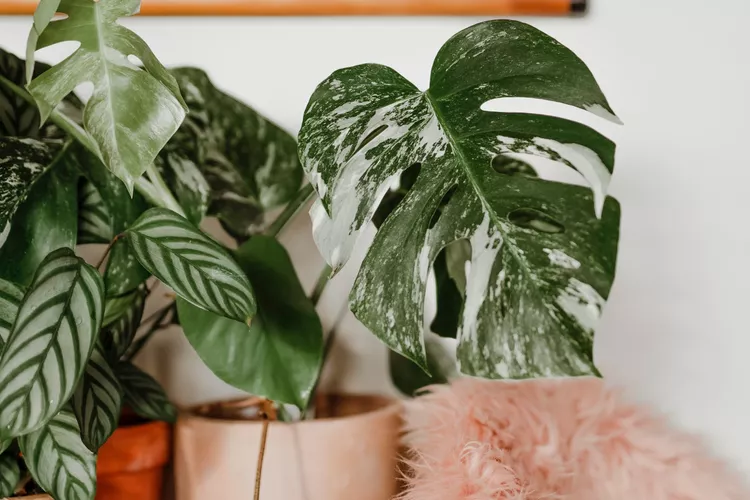The Rise of Variegated Monstera Deliciosa: A Plant Enthusiast’s Guide
Once the exclusive domain of collectors, variegated Monstera deliciosa plants are now becoming a popular addition in many homes and plant collections. So, what’s the buzz about these unique plants? Let’s dive in and explore everything you need to know about variegated monsteras.
Understanding Variegation
Variegation refers to the occurrence of different colors in the leaves and stems of plants. This phenomenon is typically due to a lack of chlorophyll in some of the plant’s cells, often resulting from cell mutations. Occasionally, fungal infections can also create variegated patterns in leaves. Variegation can manifest in a variety of hues and patterns, including two-toned, tri-colored, or even quadricolored foliage. The patterns may appear as splotches, stripes, dots, blocks, and more.
Types of Variegated Monstera Deliciosa
Variegated Monstera deliciosa plants come in several varieties, each with its own unique appeal. Here are the five main types you might encounter:
- Monstera deliciosa ‘Thai Constellation’
- Description: The most popular and accessible variety in the U.S., characterized by star-like speckles of creamy white and light yellow.
- Features: Nearly every leaf displays some form of variegation, distinguishing it from other varieties that may have non-variegated leaves.
- Monstera deliciosa ‘Albo Borsigiana’
- Description: Known for its striking pure white variegation in a blocky, splotchy pattern.
- Features: Often produces pure white leaves on mature plants and has smaller, more compact leaves compared to other varieties.
- Monstera deliciosa ‘Aurea’ (or ‘Marmorata’)
- Description: Less common, featuring yellow variegation in a splotchy pattern.
- Features: Typically more compact, with leaves rarely exceeding two feet in diameter. Some leaves may develop with little or no variegation.
- Mint Monstera
- Description: The newest and rarest variety, characterized by minty green or white-green marbled variegation.
- Features: Variegation is inconsistent, with bright white often appearing among the leaves.
- Monstera deliciosa ‘Variegata’
- Description: Known as the “true” variegated Monstera, featuring unpredictable variegation resulting from genetic mutation.
- Features: The variegation varies widely in colors and patterns, making it rare and not commonly sold commercially.
Why Are Variegated Monsteras So Expensive?
Variegated Monsteras are prized for their beauty and scarcity, making them a high-cost investment for plant enthusiasts. Here’s why they command such high prices:
- Limited Availability: Many variegated varieties cannot be grown from seed. For instance, the Thai Constellation is lab-cultured, and the Albo Monstera propagates from cuttings of a mutated mother plant, leading to limited supply.
- Cultivation Challenges: Variegated Monsteras are more delicate and harder to grow than their non-variegated counterparts. This makes them difficult to ship and maintain, adding to their rarity and expense.
Buying a Variegated Monstera: Tips and Considerations
If you’re looking to add a variegated Monstera to your collection, keep these tips in mind:
- Beware of Seed Scams: Most variegated Monstera varieties cannot be grown from seed, so avoid offers for Thai Constellation or Albo Monstera seeds.
- Look for Nodes in Cuttings: Ensure any cutting you purchase has at least one node, necessary for the plant to root and grow.
- Avoid Overly Variegated Cuttings: While tempting, cuttings that are fully white or heavily variegated may lack the chlorophyll needed for survival.
Variegated Monsteras are available through online specialty retailers, local plant nurseries, and occasionally in big box stores.
FAQs
Is it difficult to care for variegated Monsteras? Variegated Monsteras require care similar to the classic M. deliciosa but grow slower due to their variegation, affecting watering needs and increasing the risk of root rot. While not overly challenging, they can pose some difficulties for beginners.
How often should variegated Monsteras be watered? Due to their slower growth, avoid a fixed watering schedule. Instead, water them deeply when the soil is completely dry, which is less frequent in winter. A moisture meter can help determine if the soil is dry.
Can you increase variegation in a Monstera? Maintaining strong variegation requires adequate light. If new leaves lack variegation, increase light exposure. However, you can’t force more variegated leaves, and highly variegated leaves may die off due to reduced photosynthesis efficiency.
By understanding the unique needs and characteristics of variegated Monsteras, you can enjoy these stunning plants and make them a beautiful part of your collection.




